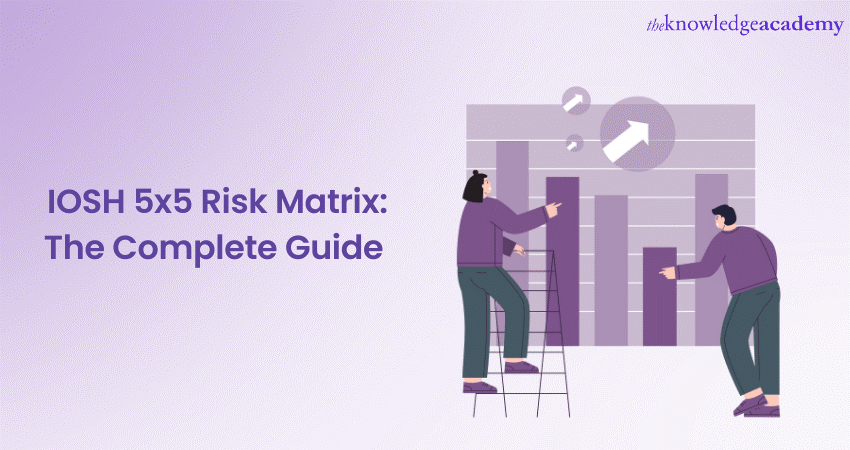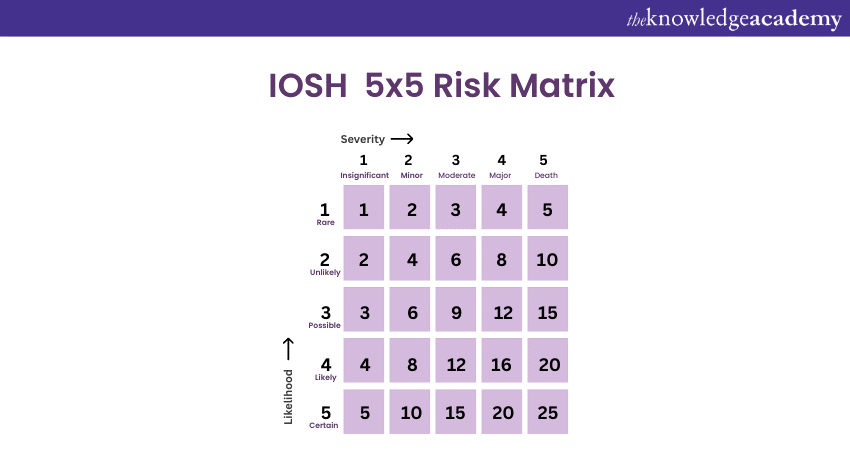We may not have the course you’re looking for. If you enquire or give us a call on 01344203999 and speak to our training experts, we may still be able to help with your training requirements.
Training Outcomes Within Your Budget!
We ensure quality, budget-alignment, and timely delivery by our expert instructors.

In today's fast-paced and complex work environments, identifying and managing risks is crucial to ensure the well-being of employees and the success of businesses. The IOSH 5x5 Risk Matrix is a risk assessment tool designed to aid organisations in evaluating and mitigating potential hazards effectively.
In this blog, we will explore the concept of the IOSH 5x5 Risk Matrix, its benefits, and how to structure it within your safety management system effectively.
Table of Contents
1) What is the IOSH 5x5 Matrix?
2) Understanding the Matrix
3) How to structure the IOSH 5x5 Risk Matrix
4) Benefits and Limitations of implementing the IOSH 5x5 Risk Matrix
5) Conclusion
What is the IOSH 5x5 Matrix?
The IOSH 5x5 Risk Matrix is a graphical representation of the relationship between the likelihood and severity of hazards. It divides risks into five categories based on likelihood and five categories based on severity. This matrix in IOSH approach allows organisations to prioritise their actions and resources based on the level of risk posed by specific hazards.
Understanding the Matrix
The 5x5 Risk Matrix consists of two main dimensions: likelihood and severity. Likelihood refers to the probability or chance of a hazard occurring, while severity relates to the potential impact or consequences of that hazard. Each dimension is divided into five levels, creating a matrix with 25 cells.

Likelihood
Let's explore the five levels of likelihood within the 5x5 Risk Matrix:
a) Rare: This level indicates that the occurrence of a hazard is highly unlikely, with a minimal chance of it happening.
b) Unlikely: Here, the probability of a hazard occurring is low but not negligible. It may happen sporadically or under specific circumstances.
c) Possible: This level suggests a moderate chance of a hazard occurring. It is neither uncommon nor frequent but falls somewhere in between.
d) Likely: Likelihood is higher at this level, indicating a significant probability of a hazard occurring. It is expected to happen occasionally or repeatedly.
e) Almost Certain: The highest level of likelihood signifies that a hazard is very likely to occur. It is anticipated to happen frequently or consistently.
Severity
Now, let's delve into the five levels of severity within the 5x5 Risk Matrix:
a) Negligible: Hazards classified under this level pose minimal or insignificant consequences. They may result in minor injuries or negligible damage.
b) Minor: This level denotes hazards that can cause minor injuries, illnesses, or damage. The impact is relatively limited and easily manageable.
c) Moderate: Hazards at this level have the potential to cause noticeable injuries, illnesses, or damage. They require attention and appropriate control measures.
d) Major: This level represents hazards that can cause significant injuries, illnesses, or damage. They have a notable impact and necessitate immediate action.
e) Catastrophic: The highest level of severity indicates hazards that can cause severe or life-threatening injuries, illnesses, or extensive damage. They require immediate and comprehensive control measures to prevent catastrophic consequences.
To effectively utilise the 5x5 Risk Matrix, you plot the likelihood and severity ratings of each identified hazard onto the matrix. By intersecting the corresponding levels, you can determine the overall risk level associated with a particular hazard. This helps prioritise risks, allocate resources, and develop appropriate control measures based on the identified risk level.
Enhance your knowledge on workplace health and safety – Sign up for IOSH Working Safely now!
How to structure the IOSH 5x5 Risk Matrix
To structure the IOSH 5x5 Risk Matrix effectively within your organisation, you need to follow a systematic approach. This ensures consistency, clarity, and ease of use when assessing and managing risks. Here are the key steps to structure the 5x5 Risk Matrix:
a) Identify potential hazards: Begin by identifying the potential risks relevant to your industry or workplace. Consider factors such as machinery, processes, substances, and environmental conditions that may harm employees' health and safety.
b) Assess likelihood and severity: Once you have identified the hazards, assess their likelihood and severity. Draw on historical data, expert knowledge, industry standards, and any available risk assessment information. Determine the likelihood and severity ratings for each hazard, keeping in mind your organisation's specific context.
c) Define likelihood and severity levels: Next, establish clear definitions and criteria for each level of likelihood and severity. This ensures consistency in rating hazards across the organisation. Develop concise descriptions for each class, making it easier for assessors to assign ratings accurately.
d) Plot likelihood and severity on the matrix: Plot the likelihood and severity ratings on the 5x5 Risk Matrix using the established levels. Assign each hazard to the appropriate cell based on its corresponding ratings. This visual representation allows for a quick assessment of the overall risk level associated with each hazard.
e) Determine risk levels: By combining the likelihood and severity ratings, you can determine the overall risk level for each hazard. Assessors can refer to the matrix to identify whether a hazard falls into low, medium, high, or extreme risk categories. This classification guides the prioritisation of control measures and resource allocation.
f) Define risk control measures: Based on the identified risk levels, develop appropriate control measures for each hazard. Consider feasible measures to reduce or eliminate the risks associated with each hazard. This may include engineering controls, administrative controls, personal protective equipment (PPE), training, or other mitigation strategies.
g) Communicate and train: Ensure that the structured 5x5 Risk Matrix and associated control measures are effectively communicated to relevant stakeholders within the organisation. Provide training and guidance on using the matrix, interpreting the risk levels, and implementing the appropriate control measures.
h) Regularly review and update: Risk assessments should be an ongoing process. Periodically review and update the 5x5 Risk Matrix as new hazards emerge, circumstances change, or when reassessment is needed. This ensures that the matrix remains relevant and effective in managing organisational risks.
Benefits and Limitations of implementing the IOSH 5x5 Risk Matrix
Implementing the 5x5 Risk Matrix offers several benefits and limitations to organisations. Listed below are four benefits and limitations each of implementing the matrix:
Benefits
a) Standardised approach: The 5x5 Risk Matrix provides a standardised approach to risk assessment within an organisation. It establishes a common framework and language for evaluating and categorising risks based on their likelihood and severity. This consistency enables better communication, comparability of risks across different departments and projects, and a unified understanding of risk levels throughout the organisation.
b) Effective resource allocation: One of the significant benefits of the 5x5 Risk Matrix is its ability to prioritise risks and allocate resources effectively. Organisations can identify high-priority risks that require immediate attention by assigning risk levels to each hazard and allocating resources accordingly. This ensures that resources, such as time, budget, and personnel, are focused on areas with the highest potential impact, enhancing the efficiency and effectiveness of risk management efforts.
c) Improved decision-making: The visual representation of risks provided by the 5x5 Risk Matrix facilitates better decision-making. It lets stakeholders quickly grasp the overall risk profile and understand the potential consequences of different hazards. This understanding empowers decision-makers to make informed choices about risk mitigation strategies, control measures, and resource allocation, leading to more effective risk management outcomes.
d) Enhanced communication and collaboration: The 5x5 Risk Matrix aids in communicating complex risk information to stakeholders. Its visual nature simplifies the presentation of risks, making it easier for individuals at all levels of the organisation to comprehend and engage with the information. This promotes better communication, collaboration, and involvement of employees in the risk assessment and mitigation process. It fosters a proactive safety culture, encourages employee engagement, and ensures everyone understands risk management's importance.
Prepare for your IOSH exam with these IOSH Managing Safely Exam Questions.
Limitations
a) Oversimplification of risks: The 5x5 Risk Matrix simplifies risks into discrete levels of likelihood and severity. This simplicity may oversimplify complex risks or fail to capture all relevant factors. Some risks may be multidimensional and require a more comprehensive assessment to understand their nature and potential consequences adequately.
b) Subjectivity in ratings: The likelihood and severity ratings in the 5x5 Risk Matrix involve a certain degree of subjectivity. Assessors may interpret and assign ratings differently based on their perspectives and experiences. This subjectivity can introduce inconsistencies in risk assessments between assessors and even within the same organisation, impacting the reliability and accuracy of the matrix's results.
c) Lack of frequency: The 5x5 Risk Matrix primarily focuses on the likelihood and severity of hazards without considering the frequency and duration of exposure. Risks that occur frequently or have prolonged exposure may pose a higher level of risk, but this aspect is not explicitly accounted for in the matrix. It is essential to supplement the matrix with additional methods to address risks that involve frequent or prolonged exposures.
d) Limited contextual factors: The 5x5 Risk Matrix does not consider specific contextual factors influencing risk levels. Factors such as organisational culture, regulatory requirements, technological advancements, and industry-specific considerations are not explicitly incorporated into the matrix. Businesses should consider these factors alongside the matrix to ensure a comprehensive and accurate assessment of risks.
Conclusion
The IOSH 5x5 Risk Matrix is a valuable tool that enables organisations to assess and manage workplace risks systematically. By effectively structuring and utilising the matrix, businesses can prioritise their safety efforts, allocate resources wisely, and improve decision-making. While acknowledging its limitations, the matrix, when integrated into a comprehensive safety management system, can significantly enhance the overall safety culture and well-being of employees.
Make your workplace safer by understanding how to make risk assessments! Register for the IOSH Managing Safely course now!
Frequently Asked Questions
Upcoming Health & Safety Resources Batches & Dates
Date
 IOSH Managing Safely Course
IOSH Managing Safely Course
Mon 2nd Sep 2024
Mon 18th Nov 2024
Mon 10th Feb 2025
Mon 28th Apr 2025
Mon 16th Jun 2025
Mon 28th Jul 2025
Mon 1st Sep 2025
Mon 3rd Nov 2025







 Top Rated Course
Top Rated Course



 If you wish to make any changes to your course, please
If you wish to make any changes to your course, please


